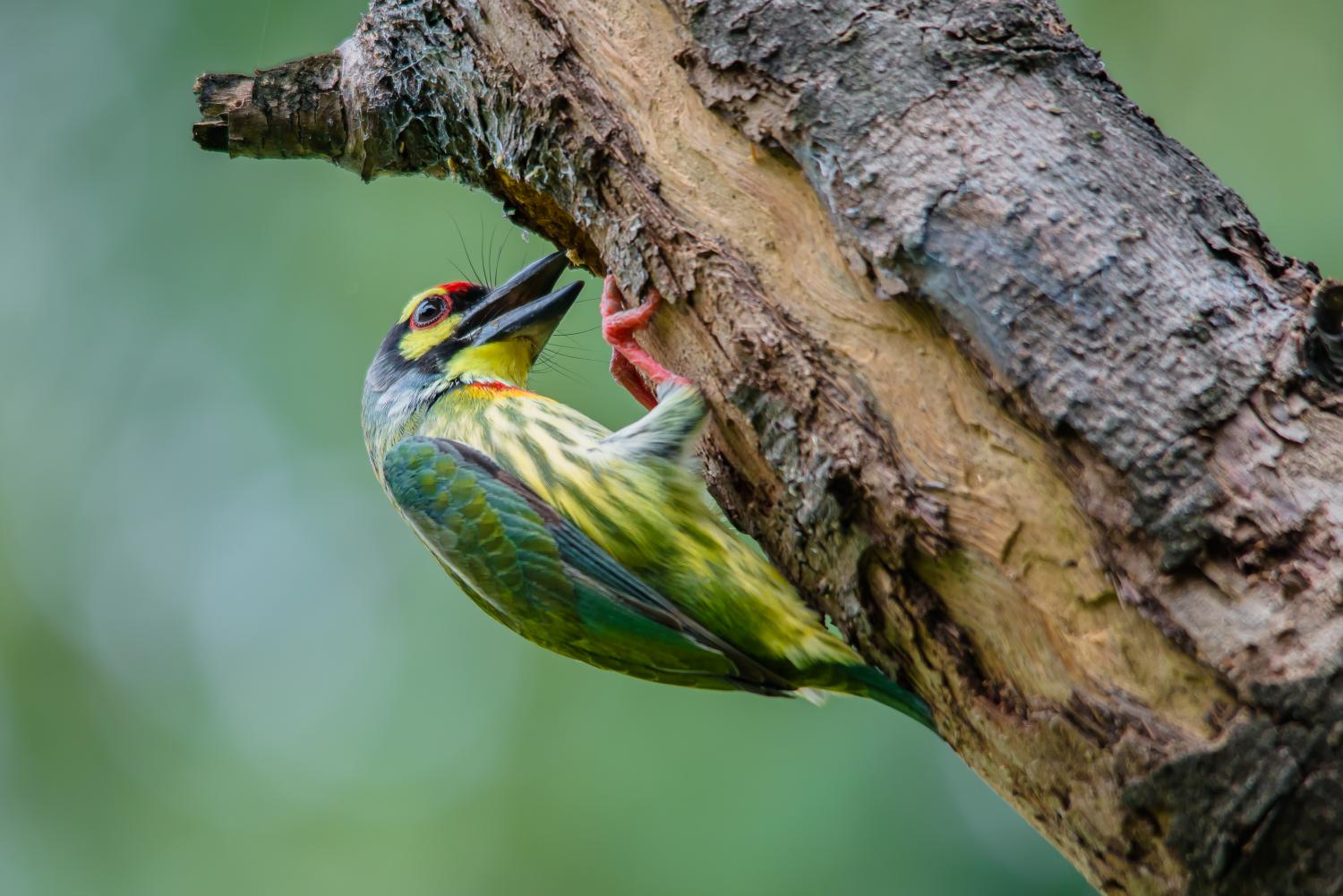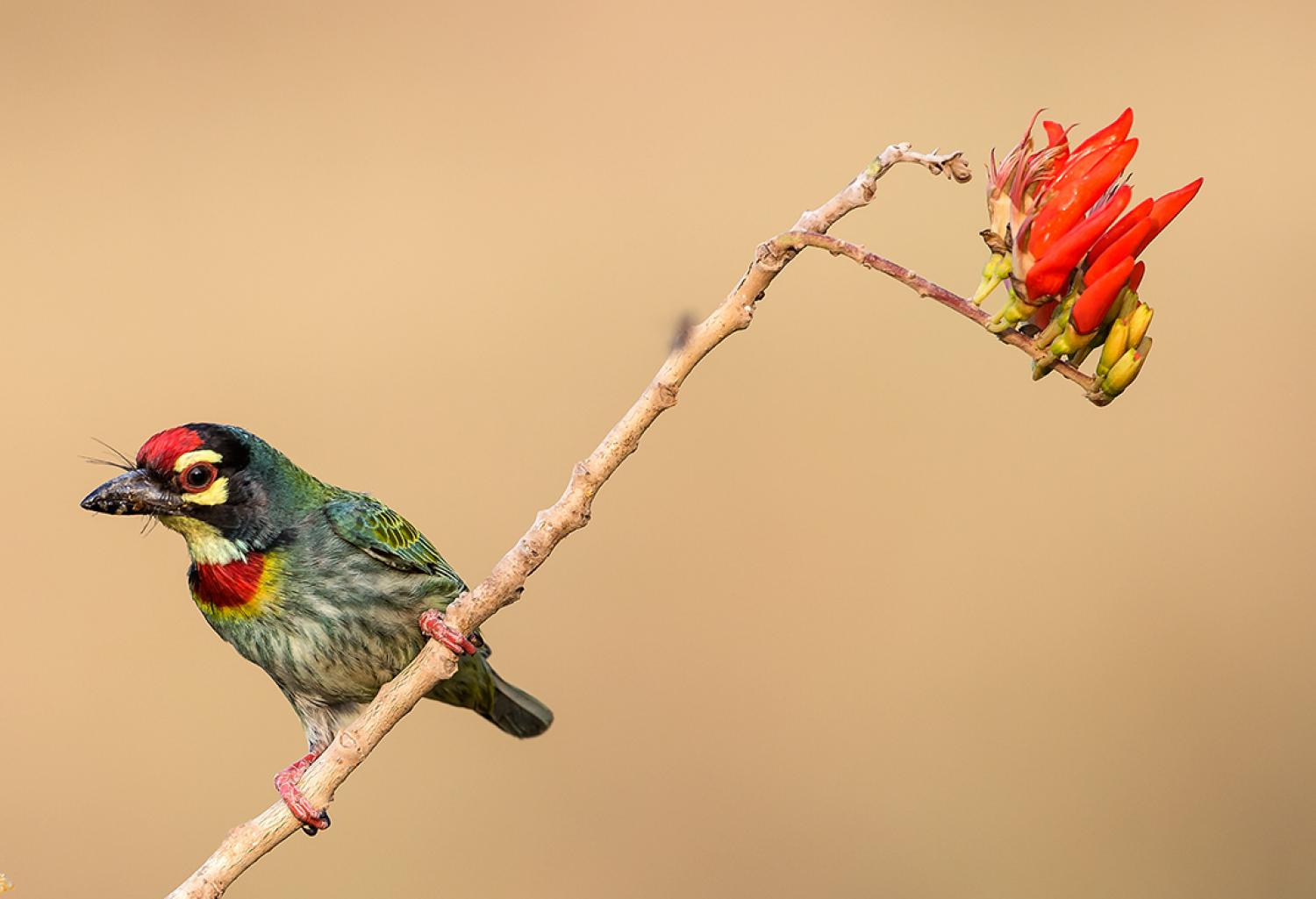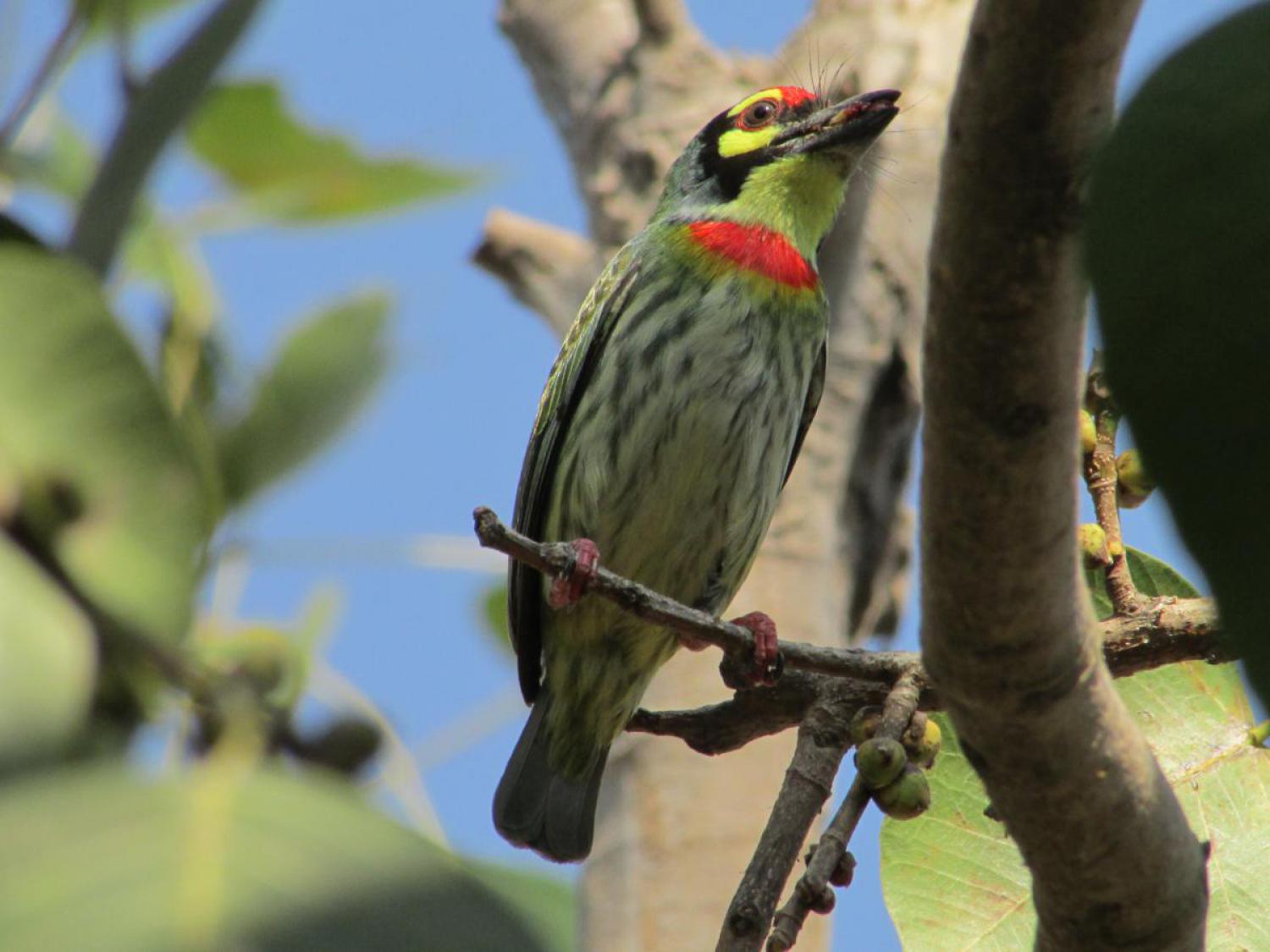Species of Thailand
Coppersmith barbet
Psilopogon haemacephalus
Statius Muller, 1776
In Thai: นกตีทอง
The coppersmith barbet (Psilopogon haemacephalus), also called crimson-breasted barbet and coppersmith, is an Asian barbet with crimson forehead and throat, known for its metronomic call that sounds similar to a coppersmith striking metal with a hammer. It is a resident bird in the Indian subcontinent and parts of Southeast Asia. It carves out holes inside a tree to build its nest. It is predominantly frugivorous, but has been observed eating insects, especially winged termites.
Description
The coppersmith barbet is green with a red head, yellow cheeks and a yellow throat. Its underparts are streaked in grey and black.
During the nesting season, the wear and tear on the feathers can cause the plumage of the upper back to appear bluish.
It is 15 - 17 cm long and weighs 30 - 52.6 g.
Taxonomy
Bucco haemacephalus was the scientific name proposed by Philipp Ludwig Statius Müller in 1776 for a barbet from the Philippines.
Bucco indicus was proposed by John Latham in 1790 for a streaked barbet from India with a black head and red forehead.
Bucco roseus was proposed by Charles Dumont de Sainte-Croix in 1816.
Asian barbets were placed in the genus Megalaima proposed by George Robert Gray in 1842 who suggested to use this name instead of Bucco.
Xantholaema intermedia proposed by George Ernest Shelley in 1891 were barbets from Negros and Cebu islands in the collection of the British Museum.
Megalaima haemacephala delica proposed by Carl Parrot in 1910 were four barbets from Deli and Sumatra in the Bavarian State Collection of Zoology.
Megalaima haemacephala mindanensis proposed by Austin L. Rand in 1948 was a coppersmith barbet from Mount Apo in Mindanao.
Megalaema haemacephala celestinoi proposed by Ernest Thomas Gilliard in 1949 was a coppersmith barbet from Samar island of the Philippines.
Megalaema haemacephala cebuensis and Megalaema haemacephala homochroa proposed by Victoria Dziadosz and Kenneth Parkes in 1984 were coppersmith barbets from Toledo, Cebu and Tablas Island, respectively.
Molecular phylogenetic research of barbets revealed that Megalaima species form a clade, which also includes the fire-tufted barbet, the only species placed in the genus Psilopogon at the time. Asian barbets were therefore reclassified under Psilopogon, which is the older scientific name. The coppersmith barbet is one of the oldest Asian barbets in terms of genetic divergence and speciation.
Nine coppersmith barbet subspecies are recognized as of 2014:
- the nominate subspecies P. h. haemacephalus occurs in Luzon and Mindoro
- P. h. indicus ranges from northeastern Pakistan to Sri Lanka, China, Vietnam and Singapore
- P. h. roseus occurs in Java and Bali
- P. h. intermedia occurs in Panay, Guimaras and Negros
- P. h. delicus occurs in Sumatra
- P. h. mindanensis occurs in Mindanao
- P. h. celestinoi occurs in Samar, Catanduanes, Biliran, and Leyte
- P. h. cebuensis occurs in Cebu
- P. h. homochroa occurs in Tablas Island
Distribution and habitat
Throughout its range, it inhabits gardens, groves and sparse woodland. Habitats with dead wood suitable for excavation of nests are important.
In the Palni Hills it occurs below 4000 order=flip. In northern India, it occurs in the valleys of the outer Himalayas up to 3000 order=flip. It is rare in northwestern Indian states and in wet forests in Assam.
The coppersmith barbet's range overlaps with several larger barbets in most of South Asia. In the Western Ghats, its range partly overlaps with the Malabar barbet.
Behaviour and ecology
The coppersmith barbet lives solitary or in small groups; larger parties have occasionally been sighted in abundantly fruiting Ficus trees. It appears to be fond of sunning in the morning on bare top branches of tall trees, often flitting about to sit next to each other. Its flight is straight, with rapid flaps.
It competes with other cavity nesting birds and frugivores. Blue-throated barbets have been seen evicting coppersmith barbets from their nest holes, while red-vented bulbuls have been seen to indulge in kleptoparasitism, robbing the male of berries brought to the female at the nest.
The nest holes are also used for roosting and some birds roost alone in cavities and these often roost during part of the day. Immatures will roost with the parents but often return to roost early so as not to be prevented by the parents from entering the roost cavity.
Vocalization
The call is a loud rather metallic tuk…tuk…tuk (or tunk), reminiscent of a copper sheet being beaten, giving the bird its name. Repeated monotonously for long periods, starting with a subdued tuk and building up to an even volume and tempo, the latter varying from 108 to 121 per minute and can continue with as many as 204 notes. They are silent and do not call in winter.
The beak remains shut during each call - a patch of bare skin on both sides of the throat inflates and collapses with each tuk like a rubber bulb and the head is bobbed.
Diet
The coppersmith barbet prefers banyan, peepul, and other wild figs, various drupes and berries, and the occasional insect, caught in aerial sallies. It also feeds on flower petals. It eats nearly 1.5 to nearly 3 times its own body weight in berries each day.
Breeding
Courtship involves singing, puffing of the throat, bobbing of the head, flicking of the tail, ritual feeding and allopreening. Birds nest and roost in cavities.
It breeds through much of the year with local variation. The breeding season is mainly February to April in India and December to September in Sri Lanka. Both sexes excavate the nest on the underside of a narrow horizontal branch. They also roost inside the nest holes. The female lays three or four eggs. Both sexes incubate. The Incubation period is not well known, but has been estimated to be about two weeks. Often two broods are raised in quick succession.
Mortality factors
Adult birds are sometimes taken by predatory species. In urban areas, there are records of collisions with structures including white walls. Pesticide poisoning has also been noted.
This article uses material from Wikipedia released under the Creative Commons Attribution-Share-Alike Licence 3.0. Eventual photos shown in this page may or may not be from Wikipedia, please see the license details for photos in photo by-lines.
Category / Seasonal Status
BCST Category: Recorded in an apparently wild state within the last 50 years
BCST Seasonal status: Resident or presumed resident
Scientific classification
- Kingdom
- Animalia
- Phylum
- Chordata
- Class
- Aves
- Order
- Piciformes
- Family
- Megalaimidae
- Genus
- Psilopogon
- Species
- Psilopogon haemacephalus
Common names
- Thai: นกตีทอง
Subspecies
Megalaima haemacephala cebuensis, Victoria M. Dziadosz & Kenneth Carroll Parkes, 1984
Range: Cebu
Megalaima haemacephala celestinoi, Ernest Thomas Gilliard, 1949
Range: Catanduanes, Biliran, Samar, Leyte
Megalaima haemacephala delica, Carl Parrot, 1907
Range: Sumatra
Megalaima haemacephala haemacephala (nominate), Philipp Ludwig Statius Müller, 1776
Range: Found in the Islands of the Luzon and Mindoro in the Philippines
Megalaima haemacephala homochroa, Victoria M. Dziadosz & Kenneth Carroll Parkes, 1984
Range: Tablas
Megalaima haemacephala indica, John Aubrey Clarendon Latham, 1790
Range: Found in the Indian subcontinent form northeastern Pakistan and extends into Sri Lanka and Vietnam. Several former supspecies from India are synonymized into indica.
Megalaima haemacephala intermedia, George Ernest Shelley, 1891
Range: Panay, Guimaras, Negros
Megalaima haemacephala mindanensis, Austin Loomer Rand, 1948
Range: Mindanao
Megalaima haemacephala rosea, Charles Dumont de Sainte-Croix, 1816
Range: Java
Synonyms
- Megalaima haemacephala
- Bucco indicus
- Xantholaema haemacephala
Conservation status

Least Concern (IUCN3.1)
Photos
Please help us review the bird photos if wrong ones are used. We can be reached via our contact us page.
Range Map

- Amphawa District, Samut Songkhram
- Ao Phang-Nga National Park
- Ban Bueng District, Chonburi
- Ban Chang District, Rayong
- Ban Laem District, Phetchaburi
- Ban Lat District, Phetchaburi
- Ban Phai District, Khon Kaen
- Ban Pho District, Chachoengsao
- Ban Sang District, Prachinburi
- Bang Kruai District, Nonthaburi
- Bang Lamung District, Chonburi
- Bang Len District, Nakhon Pathom
- Bang Pa In District, Phra Nakhon Si Ayutthaya
- Bang Pahan District, Phra Nakhon Si Ayutthaya
- Bang Phra Non-Hunting Area
- Bang Pu Recreation Centre
- Bangkok Province
- Borabue District, Maha Sarakham
- Bueng Boraped Non-Hunting Area
- Chaiya District, Surat Thani
- Chaloem Phra Kiat District, Saraburi
- Chaloem Rattanakosin National Park
- Chiang Dao District, Chiang Mai
- Chiang Dao Wildlife Sanctuary
- Chiang Khong District, Chiang Rai
- Chiang Saen District, Chiang Rai
- Doi Chong National Park
- Doi Inthanon National Park
- Doi Lo District, Chiang Mai
- Doi Pha Hom Pok National Park
- Doi Saket District, Chiang Mai
- Doi Suthep - Pui National Park
- Doi Tao District, Chiang Mai
- Don Chedi District, Suphan Buri
- Dong Kheng Forest Park
- Erawan National Park
- Fang District, Chiang Mai
- Hala-Bala Wildlife Sanctuary
- Hang Chat District, Lampang
- Hat Wanakon National Park
- Hat Yai District, Songkhla
- Huai Chorakhe Mak Reservoir Non-Hunting Area
- Huai Kha Khaeng Wildlife Sanctuary
- Huai Krachao District, Kanchanaburi
- Huai Nam Dang National Park
- Huai Talat Reservoir Non-Hunting Area
- In Buri District, Sing Buri
- Kabin Buri District, Prachinburi
- Kaeng Khoi District, Saraburi
- Kaeng Krachan District, Phetchaburi
- Kaeng Krachan National Park
- Kamphaeng Saen District, Nakhon Pathom
- Kanthararom District, Sisaket
- Kantharawichai District, Maha Sarakham
- Kaset Sombun District, Chaiyaphum
- Khanom District, Nakhon Si Thammarat
- Khao Ang Rue Nai Wildlife Sanctuary
- Khao Khiao - Khao Chomphu Wildlife Sanctuary
- Khao Kradong Forest Park
- Khao Laem National Park
- Khao Laem Ya - Mu Ko Samet National Park
- Khao Lak - Lam Ru National Park
- Khao Luang National Park
- Khao Phra - Bang Khram Wildlife Sanctuary
- Khao Phra Thaeo Wildlife Sanctuary
- Khao Sam Roi Yot National Park
- Khao Sanam Prieng Wildlife Sanctuary
- Khao Soi Dao Wildlife Sanctuary
- Khao Sok National Park
- Khao Yai National Park
- Khao Yoi District, Phetchaburi
- Khlong Hoi Khong District, Songkhla
- Khlong Luang District, Pathum Thani
- Khlong Nakha Wildlife Sanctuary
- Khlong Phanom National Park
- Khlong Saeng Wildlife Sanctuary
- Khok Sung District, Sa Kaeo
- Khon San District, Chaiyaphum
- Khuan Khanun District, Phatthalung
- Khun Chae National Park
- Khun Tan District, Chiang Rai
- Khung Kraben Non-Hunting Area
- Khura Buri District, Phang Nga
- Klaeng District, Rayong
- Ko Chang National Park
- Ko Lanta National Park
- Ko Phayam
- Ko Phra Thong
- Ko Samui District, Surat Thani
- Ko Sichang District, Chonburi
- Ko Tao
- Kui Buri National Park
- Kumphawapi District, Udon Thani
- Laem Pak Bia
- Laem Son National Park
- Lam Nam Kok National Park
- Lan Sang National Park
- Mae Ai District, Chiang Mai
- Mae Chan District, Chiang Rai
- Mae Fa Luang District, Chiang Rai
- Mae Ping National Park
- Mae Rim District, Chiang Mai
- Mae Taeng District, Chiang Mai
- Mae Wong National Park
- Muak Lek District, Saraburi
- Mueang Buriram District, Buriram
- Mueang Chachoengsao District, Chachoengsao
- Mueang Chaiyaphum District, Chaiyaphum
- Mueang Chanthaburi District, Chanthaburi
- Mueang Chiang Mai District, Chiang Mai
- Mueang Chiang Rai District, Chiang Rai
- Mueang Chonburi District, Chonburi
- Mueang Chumphon District, Chumphon
- Mueang Kalasin District, Kalasin
- Mueang Kanchanaburi District, Kanchanaburi
- Mueang Khon Kaen District, Khon Kaen
- Mueang Krabi District, Krabi
- Mueang Lamphun District, Lamphun
- Mueang Lopburi District, Lopburi
- Mueang Maha Sarakham District, Maha Sarakham
- Mueang Nakhon Nayok District, Nakhon Nayok
- Mueang Nakhon Pathom District, Nakhon Pathom
- Mueang Nakhon Ratchasima District, Nakhon Ratchasima
- Mueang Nakhon Si Thammarat District, Nakhon Si Thammarat
- Mueang Nan District, Nan
- Mueang Nong Khai District, Nong Khai
- Mueang Nonthaburi District, Nonthaburi
- Mueang Pan District, Lampang
- Mueang Pathum Thani District, Pathum Thani
- Mueang Pattani District, Pattani
- Mueang Phang Nga District, Phang Nga
- Mueang Phatthalung District, Phatthalung
- Mueang Phayao District, Phayao
- Mueang Phetchaburi District, Phetchaburi
- Mueang Phichit District, Phichit
- Mueang Phitsanulok District, Phitsanulok
- Mueang Phuket District, Phuket
- Mueang Prachinburi District, Prachinburi
- Mueang Ratchaburi District, Ratchaburi
- Mueang Rayong District, Rayong
- Mueang Sa Kaeo District, Sa Kaeo
- Mueang Samut Sakhon District, Samut Sakhon
- Mueang Saraburi District, Saraburi
- Mueang Satun District, Satun
- Mueang Sisaket District, Sisaket
- Mueang Songkhla District, Songkhla
- Mueang Sukhothai District, Sukhothai
- Mueang Suphanburi District, Suphan Buri
- Mueang Surat Thani District, Surat Thani
- Mueang Surin District, Surin
- Mueang Tak District, Tak
- Mueang Udon Thani District, Udon Thani
- Nam Nao National Park
- Namtok Mae Surin National Park
- Namtok Sam Lan National Park
- Non Sang District, Nong Bua Lamphu
- Nong Bong Khai Non-Hunting Area
- Nong Han Lake
- Nong Prue District, Kanchanaburi
- Nong Song Hong District, Khon Kaen
- Nong Suea District, Pathum Thani
- Nong Thung Thong Non-Hunting Area
- Nong Wua So District, Udon Thani
- Nong Ya Plong District, Phetchaburi
- Omkoi Wildlife Sanctuary
- Op Khan National Park
- Pa Sang District, Lamphun
- Pai District, Mae Hong Son
- Pak Chong District, Nakhon Ratchasima
- Pak Kret District, Nonthaburi
- Pak Phli District, Nakhon Nayok
- Pak Thale
- Pak Tho District, Ratchaburi
- Pak Thong Chai District, Nakhon Ratchasima
- Pang Sida National Park
- Pha Daeng National Park
- Pha Hin Ngam National Park
- Pha Nam Yoi Forest Park
- Phan District, Chiang Rai
- Phanat Nikhom District, Chonburi
- Phatthana Nikhom District, Lopburi
- Phi Phi Islands
- Phimai District, Nakhon Ratchasima
- Pho Prathap Chang District, Phichit
- Phra Nakhon Si Ayutthaya District, Phra Nakhon Si Ayutthaya
- Phu Chong Na Yoi National Park
- Phu Foi Lom National Park
- Phu Hin Rong Kla National Park
- Phu Khiao Wildlife Sanctuary
- Phu Langka National Park
- Phu Pha Thoep National Park
- Phu Sa Dok Bua National Park
- Phu Soi Dao National Park
- Phu Suan Sai National Park
- Phu Toei National Park
- Phu Wiang National Park
- Phunphin District, Surat Thani
- Phutthamonthon District, Nakhon Pathom
- Pran Buri District, Prachuap Khiri Khan
- Pran Buri Forest Park
- Ramkhamhaeng National Park
- Sai Noi District, Nonthaburi
- Sai Yok District, Kanchanaburi
- Sai Yok National Park
- Sakaerat Environmental Research Station
- Salak Pra Wildlife Sanctuary
- Salawin National Park
- Samae San Island
- Samut Prakan Province
- San Kala Khiri National Park
- San Sai District, Chiang Mai
- Sanam Bin Reservoir Non-Hunting Area
- Sanam Chai Khet District, Chachoengsao
- Santi Suk District, Nan
- Sathing Phra District, Songkhla
- Sattahip District, Chonburi
- Satuek District, Buriram
- Sawi District, Chumphon
- Si Racha District, Chonburi
- Si Satchanalai District, Sukhothai
- Si Sawat District, Kanchanaburi
- Si Thep District, Phetchabun
- Similan Islands
- Sirinat National Park
- Sri Nakarin Dam National Park
- Sri Phang-nga National Park
- Takua Pa District, Phang Nga
- Taphan Hin District, Phichit
- Tha Sala District, Nakhon Si Thammarat
- Tha Takiap District, Chachoengsao
- Tha Yang District, Phetchaburi
- Thai Mueang District, Phang Nga
- Thalang District, Phuket
- Thale Noi Non-Hunting Area
- Tham Pratun Non-Hunting Area
- Than Sadet - Koh Pha-Ngan National Park
- Thanyaburi District, Pathum Thani
- Thao Kosa Forest Park
- Thap Lan National Park
- Thong Pha Phum District, Kanchanaburi
- Thong Pha Phum National Park
- Thung Salaeng Luang National Park
- Thung Yai Naresuan Wildlife Sanctuary
- Umphang Wildlife Sanctuary
- Wang Chan District, Rayong
- Wat Phai Lom & Wat Ampu Wararam Non-Hunting Area
- Wat Tham Erawan Non-Hunting Area
- Wiang Kaen District, Chiang Rai
- Yan Ta Khao District, Trang



